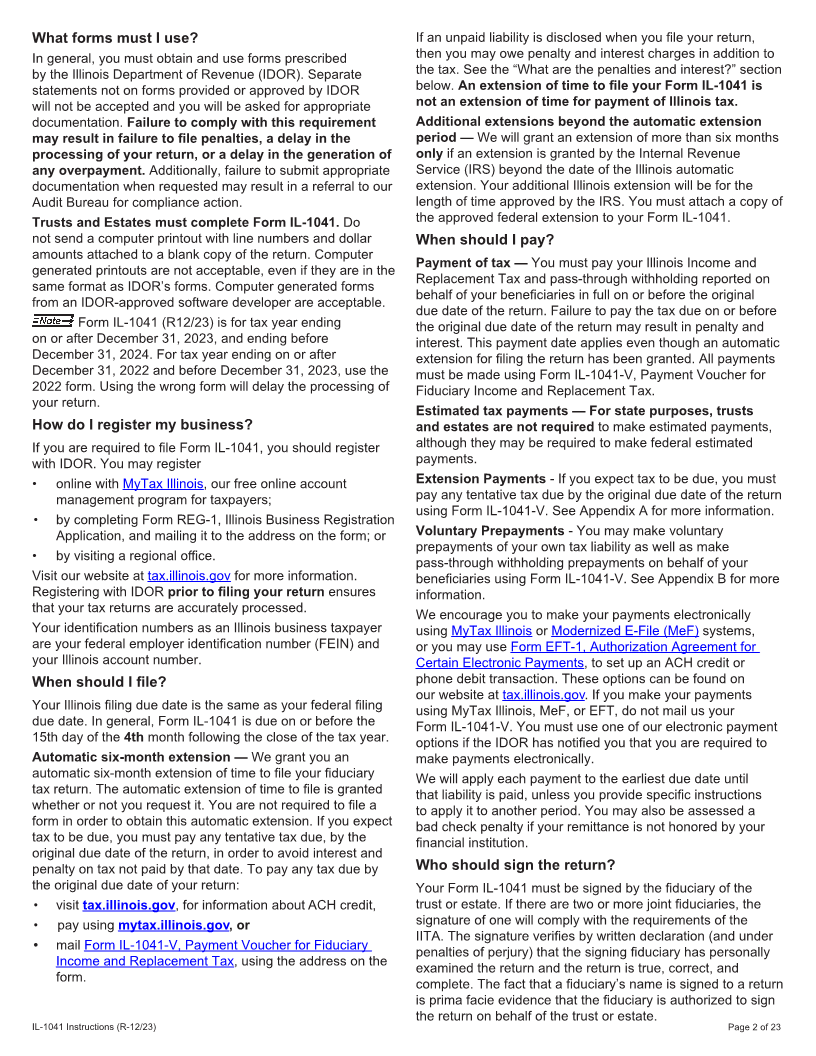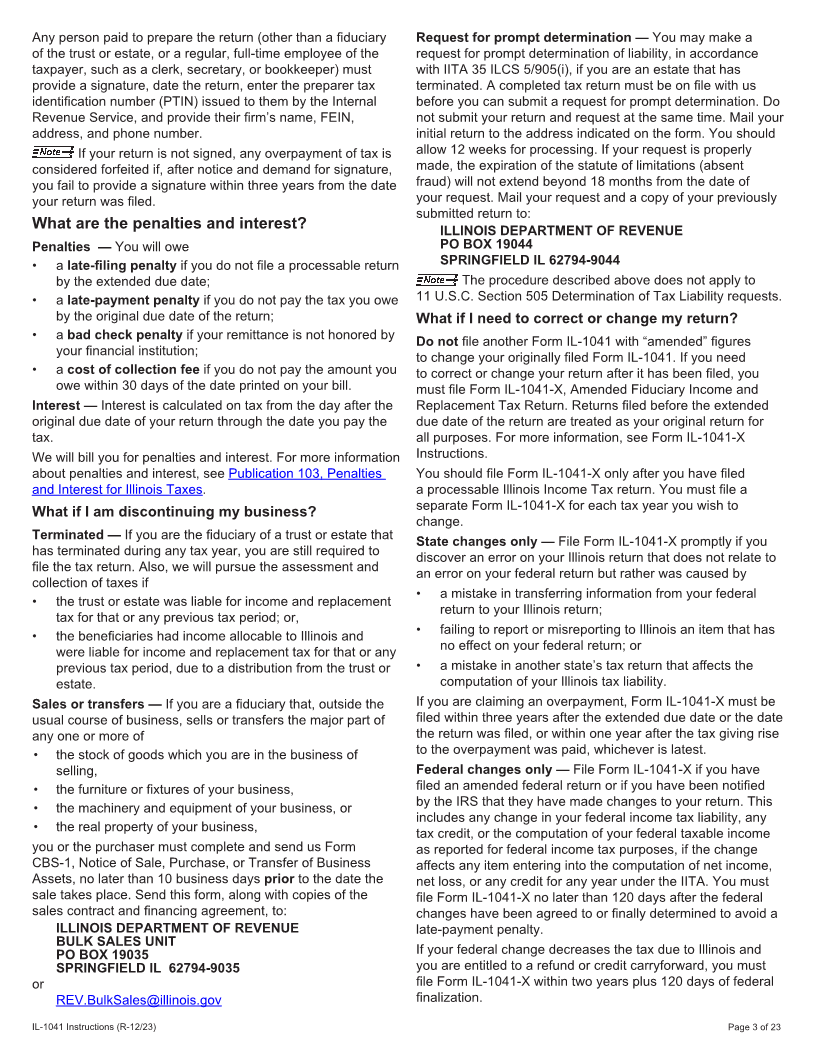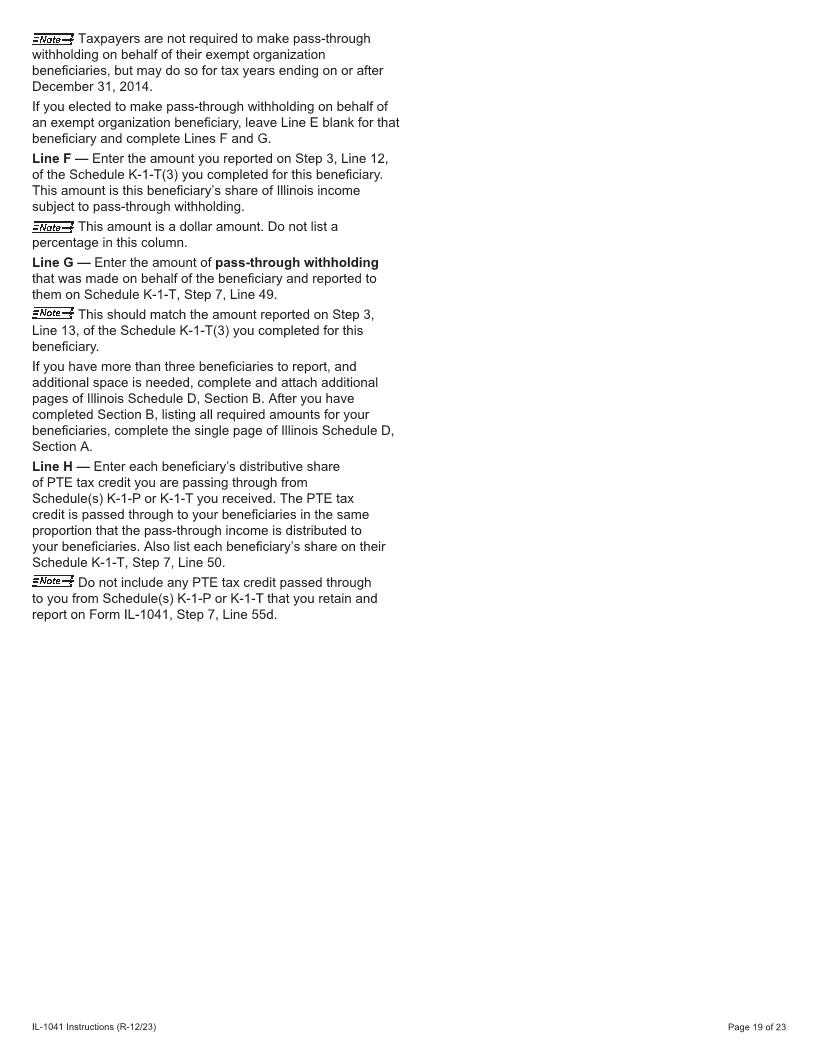
Enlarge image
Illinois Department of Revenue
Use for tax year ending on or after
December 31, 2023, and before
December 31, 2024.
IL-1041 Instructions 2023
What’s New? Table of Contents
• The address change checkbox has been removed from Step 1, What’s New? ........................................................ 1
Line B, of the Form IL-1041.
• A grantor trust checkbox has been added to Step 1, Line D, of the General Information ............................................ 1
Form IL-1041.
• IL-4562 has been expanded and includes 60 percent bonus Specific Instructions ........................................... 8
depreciation.
• Schedule D, Section B, has been reformatted from 4 columns to 3
Illinois Schedule D Instructions ....................... 17
columns.
• Schedule M has been expanded and includes a new subtraction
line for cannabis establishments that had deductions disallowed Appendix A - Extension Tax Payment
federally under IRC Section 280E. Worksheet .......................................................... 20
• Income Tax Credits -- Information about all the credits can be
found in Schedule 1299-I. Appendix B - Tax Prepayment
• The following credits have updated expiration dates: Worksheets ........................................................ 21
• Historic Preservation tax credit (Credit Code 1030) - ending
on or before December 31, 2028
• New Markets Development tax credit (Credit Code 5500) -
ending on or before June 30, 2031
• No new credits will be issued for the:
• Agritourism Liability Insurance income tax credit (Credit
Code 5440) for tax years ending after December 31, 2023
• Invest in Kids credit (Credit Code 5660) for tax years ending
after December 31, 2023
• Illinois business payment vouchers are no longer year specific.
To avoid processing delays, taxpayers submitting paper
business vouchers to the Illinois Department of Revenue should
ensure that the month and year of their filing period are entered
on each voucher. Do not enter your estimated payment due date.
General Information
Who must file Form IL-1041? “Grantor” trusts are not required to file Form IL-1041.
You must file Form IL-1041 if you are a fiduciary of a trust or Estates do not pay replacement tax.
an estate, and the trust or the estate If the trust or estate is a charitable organization exempt from
• has net income or loss as defined under the Illinois federal income tax by reason of Internal Revenue Code
Income Tax Act (IITA), regardless of any deduction for (IRC) Section 501(a), it is not required to file Form IL-1041.
distributions to beneficiaries; or However, unrelated business taxable income, as determined
under IRC Section 512, is subject to tax (without any
• is a resident of Illinois and files, or is required to file, a
deduction for the Illinois income tax) and must be reported
federal income tax return (regardless of net income or
on Form IL-990-T, Exempt Organization Income and
loss). (See “When is nonbusiness income allocable to
Replacement Tax Return, instead of Form IL-1041. For more
Illinois?” to help you complete your Form IL-1041); or
information, see Form IL-990-T Instructions.
• is a nonresident of Illinois but received income from
Illinois sources which was not reported as pass-through
withholding on Form IL-1120-ST, Small Business
Corporation Replacement Tax Return; Form IL-1065,
Partnership Replacement Tax Return; or Form IL-1041,
Fiduciary Income and Replacement Tax Return. You must
also file Illinois Schedule NR (Form IL-1041), Nonresident
Computation of Fiduciary Income, to determine the
income that is taxed by Illinois during the tax year. For
more information, see Illinois Schedule NR (Form IL-1041)
with revision date 12/23.
IL-1041 Instructions (R-12/23) Printed by the authority of the state of Illinois - electronic only - one copy. Page 1 of 23





















